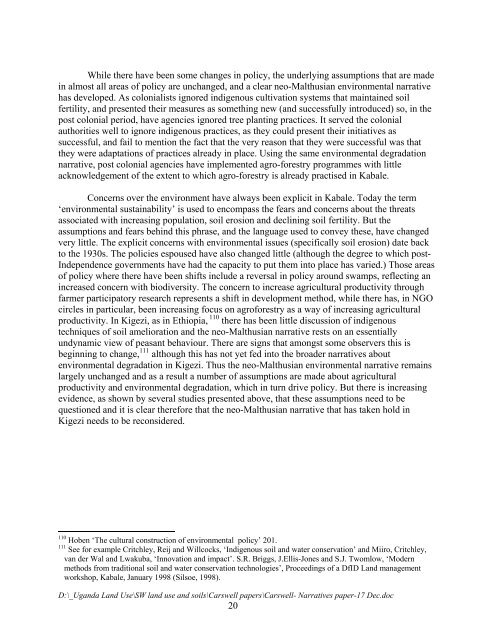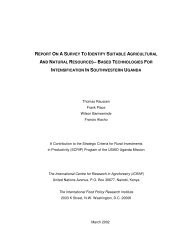Continuities in environmental narratives, Kabale, Uganda ... - Foodnet
Continuities in environmental narratives, Kabale, Uganda ... - Foodnet
Continuities in environmental narratives, Kabale, Uganda ... - Foodnet
Create successful ePaper yourself
Turn your PDF publications into a flip-book with our unique Google optimized e-Paper software.
While there have been some changes <strong>in</strong> policy, the underly<strong>in</strong>g assumptions that are made<br />
<strong>in</strong> almost all areas of policy are unchanged, and a clear neo-Malthusian <strong>environmental</strong> narrative<br />
has developed. As colonialists ignored <strong>in</strong>digenous cultivation systems that ma<strong>in</strong>ta<strong>in</strong>ed soil<br />
fertility, and presented their measures as someth<strong>in</strong>g new (and successfully <strong>in</strong>troduced) so, <strong>in</strong> the<br />
post colonial period, have agencies ignored tree plant<strong>in</strong>g practices. It served the colonial<br />
authorities well to ignore <strong>in</strong>digenous practices, as they could present their <strong>in</strong>itiatives as<br />
successful, and fail to mention the fact that the very reason that they were successful was that<br />
they were adaptations of practices already <strong>in</strong> place. Us<strong>in</strong>g the same <strong>environmental</strong> degradation<br />
narrative, post colonial agencies have implemented agro-forestry programmes with little<br />
acknowledgement of the extent to which agro-forestry is already practised <strong>in</strong> <strong>Kabale</strong>.<br />
Concerns over the environment have always been explicit <strong>in</strong> <strong>Kabale</strong>. Today the term<br />
‘<strong>environmental</strong> susta<strong>in</strong>ability’ is used to encompass the fears and concerns about the threats<br />
associated with <strong>in</strong>creas<strong>in</strong>g population, soil erosion and decl<strong>in</strong><strong>in</strong>g soil fertility. But the<br />
assumptions and fears beh<strong>in</strong>d this phrase, and the language used to convey these, have changed<br />
very little. The explicit concerns with <strong>environmental</strong> issues (specifically soil erosion) date back<br />
to the 1930s. The policies espoused have also changed little (although the degree to which post-<br />
Independence governments have had the capacity to put them <strong>in</strong>to place has varied.) Those areas<br />
of policy where there have been shifts <strong>in</strong>clude a reversal <strong>in</strong> policy around swamps, reflect<strong>in</strong>g an<br />
<strong>in</strong>creased concern with biodiversity. The concern to <strong>in</strong>crease agricultural productivity through<br />
farmer participatory research represents a shift <strong>in</strong> development method, while there has, <strong>in</strong> NGO<br />
circles <strong>in</strong> particular, been <strong>in</strong>creas<strong>in</strong>g focus on agroforestry as a way of <strong>in</strong>creas<strong>in</strong>g agricultural<br />
productivity. In Kigezi, as <strong>in</strong> Ethiopia, 110 there has been little discussion of <strong>in</strong>digenous<br />
techniques of soil amelioration and the neo-Malthusian narrative rests on an essentially<br />
undynamic view of peasant behaviour. There are signs that amongst some observers this is<br />
beg<strong>in</strong>n<strong>in</strong>g to change, 111 although this has not yet fed <strong>in</strong>to the broader <strong>narratives</strong> about<br />
<strong>environmental</strong> degradation <strong>in</strong> Kigezi. Thus the neo-Malthusian <strong>environmental</strong> narrative rema<strong>in</strong>s<br />
largely unchanged and as a result a number of assumptions are made about agricultural<br />
productivity and <strong>environmental</strong> degradation, which <strong>in</strong> turn drive policy. But there is <strong>in</strong>creas<strong>in</strong>g<br />
evidence, as shown by several studies presented above, that these assumptions need to be<br />
questioned and it is clear therefore that the neo-Malthusian narrative that has taken hold <strong>in</strong><br />
Kigezi needs to be reconsidered.<br />
110 Hoben ‘The cultural construction of <strong>environmental</strong> policy’ 201.<br />
111 See for example Critchley, Reij and Willcocks, ‘Indigenous soil and water conservation’ and Miiro, Critchley,<br />
van der Wal and Lwakuba, ‘Innovation and impact’. S.R. Briggs, J.Ellis-Jones and S.J. Twomlow, ‘Modern<br />
methods from traditional soil and water conservation technologies’, Proceed<strong>in</strong>gs of a DfID Land management<br />
workshop, <strong>Kabale</strong>, January 1998 (Silsoe, 1998).<br />
D:\_<strong>Uganda</strong> Land Use\SW land use and soils\Carswell papers\Carswell- Narratives paper-17 Dec.doc<br />
20
















